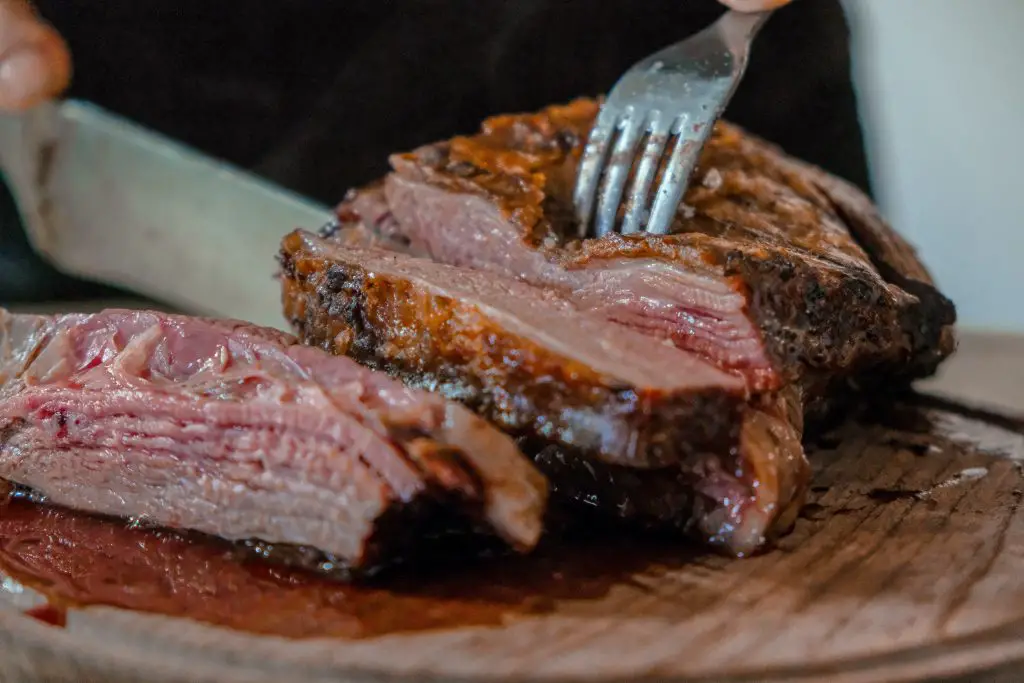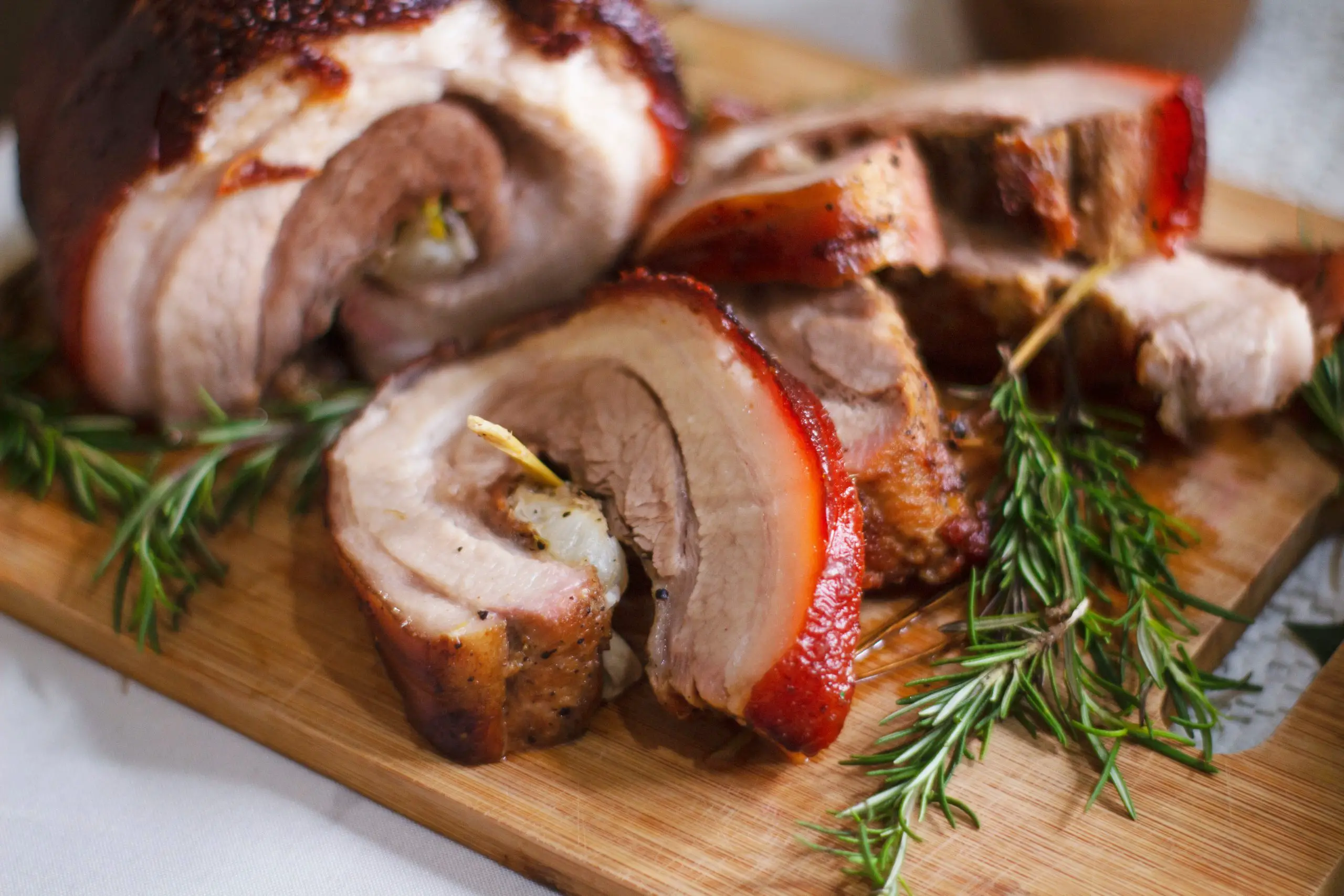The meat of the domestic pig is known in cuisine as “pork.” Evidence of pig farming dates back to 5000 BCE, making it the most widely consumed meat in the world. Curing increases the shelf life of pork products, allowing for the consumption of both freshly cooked and preserved pork. If you have leftover roast pork, there are many ways to reheat it without it becoming tough or dry.

The most important thing to do is cover and keep it warm, as this will prevent water from escaping and cause the crackling to lose its crispness. You can also try to reheat it in the microwave or an air fryer. Even on the busiest weeknights, cooking pork tenderloin is simple. Even better, leftovers may be used as a week’s worth of lunches by tucking them into sandwiches or reheating them for a fast midweek meal with roasted veggies.
How to Reheat Leftover Roast Pork?
If you want to reheat leftover roast pork, the first step is to take the meat out of the refrigerator and place it in an oven-safe dish or metal pan. This will help the meat to reheat quickly and ensure that the meat reaches the desired temperature. It is important to keep in mind that the internal temperature of the meat must remain above 165 degrees Fahrenheit.
There are many ways to reheat leftover roast pork. You can use the oven or microwave. The most important thing is not to leave the meat at room temperature for more than two hours. Once the meat is cool enough, please place it in the fridge. The leftover meat will keep for about 3 to four days. It is a good idea to use the leftover sauce if you like.
1. Reheating Leftover Roast Pork in an Oven
Preheat the oven to a minimum temperature of 325 degrees Fahrenheit. Put the pork roast pieces you wish to reheat in a skillet or oven-safe dish, such as a metal pan no deeper than 2 inches.
As a result, the meat can reheat more quickly and spend less time at a temperature where bacteria can start to grow.
Placing a Pan in the Oven: Insert the pan or dish into the preheated oven. Cook the meat: After about 20 minutes, remove it to check its internal temperature.
The thickest section of the reheated pork should contain a meat thermometer to check the temperature. The USDA Food Safety and Inspection Service recommend that pork roast and other forms of meat be reheated to an inside temperature of 165 degrees Fahrenheit.
If the temperature of the pork has not yet reached 165 degrees, put it back in the oven. Until the pork reaches the desired temperature, check its temperature every five minutes. Only then should it be served.
2. Reheating Leftover Roast Pork in a Microwave
Reheating leftover roast pork in the microwave can be a time-saving option, but keeping a few precautions in mind before you begin is important. First, ensure your roasting pan is covered, so the heat and moisture inside the pan don’t escape.
Doing so helps lock in the flavors, and it will also preserve the crisp surface. Also, it is best to reheat pork on a low to medium setting rather than on a high-power setting.
Moreover, it will be more flavorful if you wrap leftover roast pork in aluminium foil and heat it in the oven. Moreover, roasting pork in the oven will only work if you haven’t tried other reheating methods.
Also, the type of baking dish will affect the result. Although microwave cooking is a fantastic method for swiftly reheating food, it can be problematic if the dish contains sauces or other moist ingredients.
3. Reheating Leftover Roast Pork in an Air Fryer
If you’ve made whole roast pork and then forgot to reheat it, you don’t have to throw it out; reheat it in the air fryer. The key is to reheat it to the proper internal temperature. This temperature is about 165 degrees Fahrenheit. Then, allow it to rest for about 15 minutes. Once this is done, your roast pork is ready to serve.
The key is to reheat leftover roast pork correctly because reheating it without the proper pan may lead to overcooked meat. Microwaves heat the meat aggressively and unevenly and can dry out the exterior while raising the internal temperature too far. The slow and low method is best for the most succulent results and will restore the crispy exterior.
4. Reheating Leftover Roast Pork in a Toaster Oven
One way to reheat leftover roast pork is to use a toaster oven. Unlike a conventional oven, a toaster oven uses less heat and circulates it into the meat. Once the pork is reheated, it can be served with other ingredients. If you’ve roasted your pork ahead of time, wrapping it tightly in aluminium foil before placing it in the oven can improve its taste.
However, you must ensure that the pork hasn’t already been reheated before attempting this method. The type of baking dish you use also affects the outcome.
If you’ve already cooked the pork, ensure it’s at least 165 degrees Fahrenheit. The internal temperature will vary depending on the cut of meat, and it’s a great idea to utilize a meat thermometer to ensure the meat is cooked through.
5. Reheating Leftover Roast Pork in a Slow Cooker
It’s crucial to understand how long it takes to reheat roast pork in a slow cooker, so you don’t get a tough, dry piece of meat. How to reheat roast pork in a slow cooker is described below.
If you were short on ingredients, use water or stock in place of the pan drippings and add the roast pork to your slow cooker. It must reach a temperature of 165 degrees F before cooking on high for an hour.
When the roast reaches this temperature, please remove it from the slow cooker and allow it to chill completely before slicing or eating. If you want a more delicious and tender roast, add your preferred aromatic items during the final hour of cooking, such as diced onion, celery stalks, potatoes, carrots, and parsnips. This will provide a more flavorful and tender roast than other ways.
How to Reheat Leftover Roast Pork with Gravy?
There are a couple of methods for reheating leftover roast pork with gravy. The first method involves heating the pork on the stove. Before eating, ensure the meat reaches an internal temperature of 165 degrees Fahrenheit.
If the pork is too cold, you may get food poisoning. Another method involves reheating the roast in the oven. This method is healthy and easy to do. You should ensure that the roast pork is cooked before reheating it.
If the meat is not properly cooked, the meat could be dry. In this case, you can add some spices or herbs to make it more flavourful. During reheating, it is important to use the slow cooking method.
This method will keep the meat moist and will also prevent meat from becoming soggy. The meat should reach a temperature of around 165 degrees Fahrenheit, so be sure to use a meat thermometer.
How can Pork be Reheated while Remaining Moist?
The ideal method for reheating leftover pork chops is low and slow with a little additional moisture; broth or water works well. Lamb chops can be reheated in cast iron, but pig chops reheat best in the oven.
Pork tenderloin can be reheated in a skillet. Add 1-2 teaspoons of liquid (stock or water) and some butter per pork chop.
Heat on low to medium. For three to four minutes, heat the skillet with a lid on. The lid keeps the meat juicy by trapping the steam. Meat must be reheated slowly and at a low temperature to prevent drying.
The meat should be placed in a baking dish and heated all the way through in a 200–250 degree oven. It should take 20 to 30 minutes to cook a chicken breast or steak with an inch of thickness.
How can a Pork Roast be Reheated without Drying it Out?
The meat would dry out if reheated in an uncovered skillet, but a lid helps keep all that moisture and steam in, allowing the pig to absorb and retain its original flavor. Place the roast on a baking sheet with a rim and an exposed wire rack inside. Place the baking sheet in the centre of a 250° oven.
Cook until the meat reaches a temperature of 120 degrees. Utilizing paper towels, dry the surface. The easiest way to reheat leftover pork chops is slowly and with a little more moisture; broth or water works well. Lamb chops and pork tenderloin can be reheated in a cast iron pan, while pork chops reheat more effectively in the oven.
Is Cooked Pork Re-heatable?
Pork may be heated safely in the oven, microwave, or stove. Before serving, don’t forget to make sure it is thoroughly hot. It would be best if you stored a freshly prepared pork meal for reheating in the refrigerator or freezer within two hours, consumed it within three days, and only reheated it once. Reheating pig meals is certainly safe.
But it might be difficult to maintain a decent flavor and texture when reheating foods like roast pork or pork chops since the flesh can get tough and dry. Pork may be heated safely in the oven, microwave, or stove.
If you reheat the meat first, you can pull pork the next day after cooking it. Because the collagen has firmed up and the fat has resolidified, cold pork won’t fall apart as easily. It’s ideal to leave the meat whole and then reheat and shred it the next day if you’re not serving it right away.
How Should I Store Leftover Roast Pork?
If you just finished spending hours making a delicious roast pig dinner, there are leftovers. Keeping leftover roast pork for up to five days is easy with these suggestions. In an airtight container or Ziploc bag, wrap the leftover roast pork tightly in aluminium foil before storing it. Any leftovers will stay fresher for up to five days as a result. Ensure that anything not consumed immediately is refrigerated.
If there are no more containers, securely wrap the meat in plastic before covering it in aluminium foil. Extra-cooked roast pork can be frozen on a baking sheet covered with parchment paper (to prevent sticking) and then frozen.
When thoroughly frozen, transfer to a sizable shallow container coated with tinfoil and labelled with the date and contents; they should keep for three to six months.
Conclusion
Given its high level of leanness, pork tenderloin can be challenging to reheat without drying out. Especially if it’s quickly zapped in the microwave or thrown into an extremely hot oven, pork tenderloin can easily become overcooked. After all, the beauty of leftovers is speed, so when it comes to reheating pork tenderloin, I want to get it done as soon as possible while preserving the meat’s moisture.
Huge pork roasts might produce a lot of leftovers unless you’re feeding a large group of people. Keep the leftovers in the fridge and reheat the pork tenderloin for dinner the next day to prevent food waste. Just be sure to cut the leftover roast into substantial slices or pieces rather than putting the complete roast in the refrigerator, as this makes it simpler to reheat the quantity you require.
